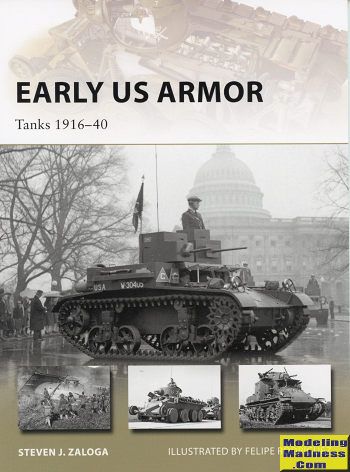 WWI
saw several revolutionary weapons of war. One of them was the tank. Though
developed by the British, the French Renault FT-17 is often considered to have
been the design that has influenced tank design more than any other. It would
not be, therefore, too surprising to know that this tank was what consisted of
much of US WWI armor. The type was even built in the US, though once the war was
over, production pretty well ceased and the tank was no longer considered to be
something that the US Army had to have.
WWI
saw several revolutionary weapons of war. One of them was the tank. Though
developed by the British, the French Renault FT-17 is often considered to have
been the design that has influenced tank design more than any other. It would
not be, therefore, too surprising to know that this tank was what consisted of
much of US WWI armor. The type was even built in the US, though once the war was
over, production pretty well ceased and the tank was no longer considered to be
something that the US Army had to have.
This is not to say that the concept went away, for there were forward
thinking officers in the US Army that saw the benefit of the tank, but so
ingrained was the horse-mounted cavalry in the senior officers that getting
funding for new tank designs was quite difficult. Indeed, even in 1941, there
were still horse mounted cavalry units in the US.
Thanks to the reduction in the military after WWI and the following
Great Depression, money simply was not there for tanks. Not to say that the type
wasn't designed, tested and put into limited use, but not in any sort of
numbers.
In line with European powers, American tanks of the 20's and 30's were
mostly smaller light tanks with relatively thin armor and small guns. The heavy
machine gun was often considered to be adequate enough and it wasn't until the
late 1930s that the use of some sort of canon capable of penetrating armor was
carried. Even this was often the 37mm version, developed along the lines of the
German anti-tank gun of the same calibre.
Eventually, it became obvious that the US would be involved in any war
in Europe and so development of more and more modern and capable tanks followed.
This book stops with the M3 light tank and M3 medium tank, but it is obvious
what comes next.
The author does a very good job of covering all the different vehicles
developed during this period; both the somewhat successful and those which were
an obvious dead end. This is superbly accompanied with some great period photos
and equally good artwork. It gives the reader an excellent look at these early
American tanks and provides a lot of insight as to how these vehicles would be
used as time progressed. An excellent read and highly recommended.
March 2017
Copyright ModelingMadness.com. All rights reserved.
For more on the complete line of Osprey books, visit
http://www.ospreypublishing.com
If you would like your product reviewed fairly and
fairly quickly, please
contact
the editor or see other details in the
Note to
Contributors.
 WWI
saw several revolutionary weapons of war. One of them was the tank. Though
developed by the British, the French Renault FT-17 is often considered to have
been the design that has influenced tank design more than any other. It would
not be, therefore, too surprising to know that this tank was what consisted of
much of US WWI armor. The type was even built in the US, though once the war was
over, production pretty well ceased and the tank was no longer considered to be
something that the US Army had to have.
WWI
saw several revolutionary weapons of war. One of them was the tank. Though
developed by the British, the French Renault FT-17 is often considered to have
been the design that has influenced tank design more than any other. It would
not be, therefore, too surprising to know that this tank was what consisted of
much of US WWI armor. The type was even built in the US, though once the war was
over, production pretty well ceased and the tank was no longer considered to be
something that the US Army had to have.